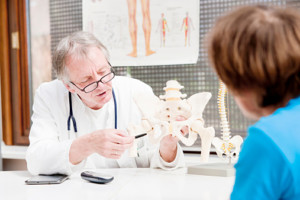 The rise in popularity of total hip replacement procedures in the United States is largely due to modern advances in technology that have produced hip replacement parts that successfully mimic the body’s natural joints. Unlike a normal hip joint, an arthritic hip joint is plagued by worn out cartilage, a rough bone surface, and decreased space for the joint to move around in — all as a result of years of movement that wear and tear on your joints.
The rise in popularity of total hip replacement procedures in the United States is largely due to modern advances in technology that have produced hip replacement parts that successfully mimic the body’s natural joints. Unlike a normal hip joint, an arthritic hip joint is plagued by worn out cartilage, a rough bone surface, and decreased space for the joint to move around in — all as a result of years of movement that wear and tear on your joints.
So today’s total hip replacement option provides a combination of four replacement pieces that effectively trade out a rough, tight joint for a smooth, spacious artificial one. Its high-quality parts consist of a titanium hip socket with a white plastic liner into which fits one of three choices for the ball of the replacement hip: cobalt chrome, oxinium, or ceramic. Then there’s the titanium hip stem that is joined with the top of the femur bone.
Prime candidates for a total hip replacement include patients who experience significant pain during weight-bearing activities as simple as standing up, walking, or exercising. Many of these candidates struggle with quality of life issues because the hip pain prevents them from walking reasonable distances, causes difficulties in putting on and taking off their socks and shoes, takes away their ability to exercise or participate in recreational activities, and limits their ability to travel when they finally have time to do so.
Total hip replacement can be a suitable solution for patients with a variety of medical diagnoses, including those who have osteoarthritis, those suffering from rheumatoid arthritis, those who have previously experienced a hip fracture, or those who have lived with a congenital hip abnormality.
However, the patient seriously considering a total hip replacement operation must be healthy enough to endure the physical demands of the surgical procedure, though a person’s physiological age is a more important factor than their chronological age.
Before resorting to a total hip replacement, other more conservative treatments are often considered, including exercise regimens that can infuse painkilling endorphins into the body and build muscles to help protect problem joints, weight loss programs that can help alleviate some of the stress on a patient’s joints, modification of activities to reduce that stress or pain, the prescription of anti-inflammatory medications, the use of assistive devices like canes or walkers, and cortisone injections to manage the inflammation caused by arthritis.
Even when surgery is selected as a treatment, the choices that face the surgeon are numerous. He or she must decide whether or not to use cement to adhere the components of a total hip replacement to the body, which logistic approach to the operation to take, which materials to use for the replacement hip, and whether or not to utilize computer assistance during the procedure.
The most significant decision for the surgeon may be whether to perform the operation from the front side (anterior) of the hip or from the back side (posterior). The anterior approach typically possesses advantages such as direct entry into the hip joint by only splitting between two muscles. Operating from the front also creates less tissue trauma, which means that the patient will likely experience a quicker return to normal functions in the days and weeks following the operation. And it leaves posterior structures intact, meaning they are less likely to dislocate after the surgery.
When it finally comes time to the operation itself, today’s surgeon has another new advantage over doctors in years past: the advanced computer. New developments in technology have led to computer-assisted surgery. Basically, computer navigation of the surgical procedure allows the doctor to see the exact angle at which the pelvis is positioned on the operating room table, which leads to a more accurate placement of the important replacement hip cup. Computers also provide live feedback to help the surgeon insert that cup, or acetabular component, more precisely. Computers can even measure the change in length of the leg being operated on in the midst of the surgery so that the chances of having leg length inequalities afterwards are reduced.
In all, advances in technology and the medical establishment’s refinement of techniques has opened up a myriad of choices for people suffering from severe hip pain and has allowed patients the hope of a vibrant quality of life beyond the development of hip pain that was once a debilitating condition.





